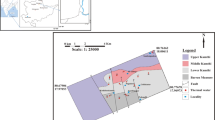Abstract
Reservoir temperature estimation is vitally important for assessing the exploitation potential of a geothermal field. In this study, the concentrations of major chemical constituents in geothermal water sampled from boiling and hot springs in the Tengchong hydrothermal area were measured, and quartz and cationic solutes geothermometers were used to calculate subsurface temperatures. Log (Q/K) diagrams and Na–K–Mg triangular diagrams were applied to evaluating the equilibrium status of geothermal water samples with regard to reservoir minerals, and results were used to select suitable geothermometers. The results show that samples RH01, RH03, RH04, RH05, and LL16 were in or very close to full equilibrium with the selected minerals, and therefore a Na–K geothermometer is appropriate. A K/Mg geothermometer, however, is applicable to LP08 and PZH18 whose chemical compositions adjusted to the shallow reservoir temperatures during their re-equilibrium processes. In contrast, cationic solute geothermometers are unsuitable for SQ20 and RH07, which are categorized as immature water in the Na–K–Mg diagram; a quartz geothermometer was adopted to evaluate the corresponding subsurface temperatures of these samples. According to the reservoir temperature estimation made in this study, there is at least one high-temperature reservoir below Rehai with a possible temperature range of 210–270 °C.






Similar content being viewed by others
References
Ahmad M et al (2002) Assessment of reservoir temperatures of thermal springs of the northern areas of Pakistan by chemical and isotope geothermometry. Geothermics 31(5):613–631
Anzil PA, Guereschi AB, Martino RD (2012) Mineral chemistry and geothermometry using relict primary minerals in the La Cocha ultramafic body: a slice of the upper mantle in the Sierra Chica of Cordoba, Sierras Pampeanas, Argentina. J S Am Earth Sci 40:38–52
Asta MP et al (2012) Hydrochemistry and geothermometrical modeling of low-temperature Panticosa geothermal system (Spain). J Volcanol Geotherm Res 235:84–95
Crerar DA, Anderson GM (1971) Solubility and solvation reactions of quartz in dilute hydrothermal solutions. Chem Geol 8:107–122
Du JG et al (2005) Variations of geothermometry and chemical-isotopic compositions of hot spring fluids in the Rehai geothermal field, Southwestern China. J Volcanol Geotherm Res 142(3–4):243–261
Dulanya Z, Morales-Simfors N, Sivertun A (2010) Comparative study of the silica and cation geothermometry of the Malawi hot springs: potential alternative energy source. J Afr Earth Sci 57(4):321–327
Ellis AJ, Wilson SH (1960) The geochemistry of metal ions in the hydrothermal system. NZ J Geol Geophys 3(4):593–617
Fournier RO, Rowe JJ (1966) Estimation of underground temperatures from the silica content of water from hot springs and wet-steam wells. Am J Sci 264:685–697
Fournier RO, Truesdell AH (1973) An empirical Na–K–Ca Geothermometer for natural waters. Geochim Cosmochim Acta 37(5):1255–1275
Giggenbach WF (1988) Geothermal solute equilibria-derivation of Na–K–Mg–Ca geoindicators. Geochim Cosmochim Acta 52(12):2749–2765
Gokgoz A, Tarcan G (2006) Mineral equilibria and geothermometry of the Dalaman-Koycegiz thermal springs, southern Turkey. Appl Geochem 21(2):253–268
Guo QH, Wang YX (2012) Geochemistry of hot springs in the Tengchong hydrothermal areas, Southwestern China. J Volcanol Geotherm Res 215:61–73
Majumdar N, Mukherjee AL, Majumdar RK (2009) Mixing hydrology and chemical equilibria in Bakreswar geothermal area, Eastern India. J Volcanol Geotherm Res 183(3–4):201–212
Mimi AL et al (1998) Application of chemical geothermometrys to thermal springs. Geothermics 27(2):211–233
Mohammadi Z, Bagheri R, Jahanshahi R (2010) Hydrogeochemistry and geothermometry of Changal thermal springs, Zagros region, Iran. Geothermics 39(3):242–249
Mutlu H (1998) Chemical geothermometry and fluid-mineral equilibria for the Omer-Gecek thermal waters, Afyon area, Turkey. J Volcanol Geotherm Res 80(3–4):303–321
Mutlu H, Gulec N (1998) Hydrogeochemical outline of thermal waters and geothermometry applications in Anatolia (Turkey). J Volcanol Geotherm Res 85(1–4):495–515
Pang ZG (2001) Isotope and chemical geothermometry and its applications. Sci China Ser E-Technol Sci 44S:16–20
Pang ZH, Reed M (1998) Theoretical chemical thermometry on geothermal waters: problems and methods. Geochim Cosmochim Acta 62(6):1083–1091
Pang ZH, Wang JY, Fan ZC (1990) Calculation of reservior temperature using a SiO2 mixing model, Zhangzhou geothermal field, SE China. Chin Sci Bull 35(16):1360–1363
Pasvanoglu S (2011) Hydrogeochemical and isotopic investigation of the Bursa-Oylat thermal waters, Turkey. Environ Earth Sci 64(4):1157–1167
Pirlo MC (2004) Hydrogeochemistry and geothermometry of thermal groundwaters from the Birdsville Track Ridge, Great Artesian Basin, South Australia. Geothermics 33(6):743–774
Reed M, Spycher N (1984) Calculation of Ph and mineral equilibria in hydrothermal waters with application to geothermometry and studies of boiling and dilution. Geochim Cosmochim Acta 48(7):1479–1492
Shangguan ZG (2000) Structure of geothermal reservoirs and the temperature of mantle-derived magma hot source in the Rehai area, Tengchong. Acta Petrol Sin 16(1):83–90
Shangguan ZG, Zhao CP, Li HZ, Gao QW, Sun ML (2005) Evolution of hydrothermal explosions at Rehai geothermal field, Tengchong volcanic region, China. Geothermics 34(4):518–526
Sun ZX, Wu HM (1999) Calculation of the fluid-rock equilibrium state and geothermal reservior temperatures in the geothermal system. Acta Geosci Sin 20:595–598
Tong W, Zhang M (1989) Geothermics in Tengchong. Science press, Beijing. (in Chinese with English abstract)
Zheng XL, Liu HJ (1996) Study of the water-rock equilibrium state in the application of geothermometer. J Xi’an Coll Geol 18(1):74–79
Zhang GP et al (2008) Geochemistry of the Rehai and Ruidian geothermal waters, Yunnan Province, China. Geothermics 37:73–83
Zheng XL, Armannsson H, Li YL, Qiu HX (2002) Chemical equilibria of thermal waters for the application of geothermometers from the Guanzhong basin, China. J Volcanol Geotherm Res 113(1–2):119–127
Acknowledgments
This study was financially supported by the National Natural Science Foundation of China (No. 41120124003), the Ministry of Education of China (111 Project, No. B08030), the Research fund of Bureau of Science and Technology of Qinghai Province (No. 2013-G-Q08A), and the Fundamental Research Fund for National Universities, China University of Geosciences (Wuhan) (Nos. CUG120505 and CUG120113). The helpful comments of two anonymous reviewers are gratefully acknowledged.
Author information
Authors and Affiliations
Corresponding author
Rights and permissions
About this article
Cite this article
Zhang, X., Guo, Q., Li, J. et al. Estimation of reservoir temperature using silica and cationic solutes geothermometers: a case study in the Tengchong geothermal area. Chin. J. Geochem. 34, 233–240 (2015). https://doi.org/10.1007/s11631-015-0037-7
Received:
Revised:
Accepted:
Published:
Issue Date:
DOI: https://doi.org/10.1007/s11631-015-0037-7




